Combining Regulatory Instruments and Low-Cost Sensors to Quantify the Effects of 2020 California Wildfires on PM2.5 in San Joaquin Valley
Abstract
1. Introduction
2. Materials and Methods
2.1. Study Location and Period
2.2. Wildfire Data and Analysis
2.2.1. Fire Perimeters and Active Fire Area
2.2.2. Fire Emission Estimation
2.2.3. Trajectory Modeling
2.3. Regulatory and Sensor Data
2.3.1. Regulatory Data
2.3.2. Low-Cost Sensors
2.4. Interpolation Analysis
2.5. Interpolation Performance and Sensitivity Analysis
2.6. AQI Calculations
3. Results and Discussions
3.1. Wildfire
Emission Trends
3.2. Air Quality
3.3. Interpolation Performance and Sensitivity Analysis
4. Conclusions and Summary
Supplementary Materials
Author Contributions
Funding
Institutional Review Board Statement
Informed Consent Statement
Data Availability Statement
Acknowledgments
Conflicts of Interest
References
- American Lung Association. State of the Air 2019; American Lung Association: Washington, DC, USA, 2019. [Google Scholar]
- California Air Resources Board. Area Designation Maps/State and National; California Air Resources Board: Sacramento, CA, USA, 2017. [Google Scholar]
- Pope, C.A., III. Lung Cancer, Cardiopulmonary Mortality, and Long-term Exposure to Fine Particulate Air Pollution. JAMA J. Am. Med. Assoc. 2002, 287, 1132–1141. [Google Scholar] [CrossRef] [PubMed]
- Zhu, S.; Horne, J.R.; Mac Kinnon, M.; Samuelsen, G.S.; Dabdub, D. Comprehensively assessing the drivers of future air quality in California. Environ. Int. 2019, 125, 386–398. [Google Scholar] [CrossRef] [PubMed]
- Cisneros, R.; Brown, P.; Cameron, L.; Gaab, E.; Gonzalez, M.; Ramondt, S.; Veloz, D.; Song, A.; Schweizer, D. Understanding public views about air quality and air pollution sources in the San Joaquin Valley, California. J. Environ. Public Health 2017, 2017, 4535142. [Google Scholar] [CrossRef]
- Abatzoglou, J.T.; Williams, A.P. Impact of anthropogenic climate change on wildfire across western US forests. Proc. Natl. Acad. Sci. USA 2016, 113, 11770–11775. [Google Scholar] [CrossRef] [PubMed]
- Hurteau, M.D.; Westerling, A.L.; Wiedinmyer, C.; Bryant, B.P. Projected effects of climate and development on California wildfire emissions through 2100. Environ. Sci. Technol. 2014, 48, 2298–2304. [Google Scholar] [CrossRef] [PubMed]
- Val Martin, M.; Heald, C.L.; Lamarque, J.-F.; Tilmes, S.; Emmons, L.K.; Schichtel, B.A. How emissions, climate, and land use change will impact mid-century air quality over the United States: A focus on effects at national parks. Atmos. Chem. Phys. 2015, 15, 2805–2823. [Google Scholar] [CrossRef]
- O’Dell, K.; Ford, B.; Fischer, E.V.; Pierce, J.R. Contribution of wildland-fire smoke to US PM2. 5 and its influence on recent trends. Environ. Sci. Technol. 2019, 53, 1797–1804. [Google Scholar] [CrossRef]
- Goss, M.; Swain, D.L.; Abatzoglou, J.T.; Sarhadi, A.; Kolden, C.A.; Williams, A.P.; Diffenbaugh, N.S. Climate change is increasing the likelihood of extreme autumn wildfire conditions across California. Environ. Res. Lett. 2020, 15, 94016. [Google Scholar] [CrossRef]
- Cisneros, R.; Schweizer, D.; Zhong, S.; Hammond, K.; Perez, M.A.; Guo, Q.; Traina, S.; Bytnerowicz, A.; Bennett, D.H. Analysing the effects of the 2002 McNally fire on air quality in the San Joaquin Valley and southern Sierra Nevada, California. Int. J. Wildl. Fire 2012, 21, 1065–1075. [Google Scholar] [CrossRef]
- Navarro, K.M.; Cisneros, R.; O’Neill, S.M.; Schweizer, D.; Larkin, N.K.; Balmes, J.R. Air-Quality Impacts and Intake Fraction of PM2.5 during the 2013 Rim Megafire. Environ. Sci. Technol. 2016, 50, 11965–11973. [Google Scholar] [CrossRef]
- Viswanathan, S.; Eria, L.; Diunugala, N.; Johnson, J.; McClean, C. An analysis of effects of San Diego wildfire on ambient air quality. J. Air Waste Manag. Assoc. 2006, 56, 56–67. [Google Scholar] [CrossRef] [PubMed]
- Gupta, P.; Doraiswamy, P.; Levy, R.; Pikelnaya, O.; Maibach, J.; Feenstra, B.; Polidori, A.; Kiros, F.; Mills, K.C. Impact of California fires on local and regional air quality: The role of a low-cost sensor network and satellite observations. GeoHealth 2018, 2, 172–181. [Google Scholar] [CrossRef] [PubMed]
- Durkin, A.; Gonzalez, R.; Isaksen, T.B.; Walker, E.; Errett, N.A. Establishing a Community Air Monitoring Network in a Wildfire Smoke-Prone Rural Community: The Motivations, Experiences, Challenges, and Ideas of Clean Air Methow’s Clean Air Ambassadors. Int. J. Environ. Res. Public Health 2020, 17, 8393. [Google Scholar] [CrossRef] [PubMed]
- Holder, A.L.; Mebust, A.K.; Maghran, L.A.; McGown, M.R.; Stewart, K.E.; Vallano, D.M.; Elleman, R.A.; Baker, K.R. Field Evaluation of Low-Cost Particulate Matter Sensors for Measuring Wildfire Smoke. Sensors 2020, 20, 4796. [Google Scholar] [CrossRef] [PubMed]
- Barkjohn, K.K.; Gantt, B.; Clements, A.L. Development and Application of a United States wide correction for PM 2.5 data collected with the PurpleAir sensor. Atmos. Meas. Tech. Discuss. 2020, 14, 4617–4637. [Google Scholar] [CrossRef] [PubMed]
- Bi, J.; Wildani, A.; Chang, H.H.; Liu, Y. Incorporating low-cost sensor measurements into high-resolution PM2. 5 modeling at a large spatial scale. Environ. Sci. Technol. 2020, 54, 2152–2162. [Google Scholar] [CrossRef] [PubMed]
- Schulte, N.; Li, X.; Ghosh, J.K.; Fine, P.M.; Epstein, S.A. Responsive high-resolution air quality index mapping using model, regulatory monitor, and sensor data in real-time. Environ. Res. Lett. 2020, 15, 1040a7. [Google Scholar] [CrossRef]
- Schroeder, W.; Oliva, P.; Giglio, L.; Csiszar, I.A. Remote Sensing of Environment The New VIIRS 375 m active fi re detection data product: Algorithm description and initial assessment. Remote Sens. Environ. 2014, 143, 85–96. [Google Scholar] [CrossRef]
- Reinhardt, E.D.; Dickinson, M.B. First-Order Fire Effects Models For Land Management: Overview and Issues. Fire Ecol. 2010, 6, 131–142. [Google Scholar] [CrossRef]
- Reinhardt, E.D.; Keane, R.E.; Brown, J.K. First Order Fire Effects User’s Guide; General Technical Report, INT-GRT-344; US Department of Agriculture, Forest Service, Intermountain Research Station: Fort Collins, CO, USA, 1997. [Google Scholar]
- Lutes, D.C. FOFEM 6.7 User Guide; Fire Management, Rocky Mountain Research Station, Fire Modeling Institute: Fort Collins, CO, USA, 2020. [Google Scholar]
- Wiedinmyer, C.; Akagi, S.K.; Yokelson, R.J.; Emmons, L.K.; Al-Saadi, J.A.; Orlando, J.J.; Soja, A.J. The Fire INventory from NCAR (FINN): A high resolution global model to estimate the emissions from open burning. Geosci. Model Dev. 2011, 4, 625. [Google Scholar] [CrossRef]
- Clinton, N.E.; Gong, P.; Scott, K. Quantification of pollutants emitted from very large wildland fires in Southern California, USA. Atmos. Environ. 2006, 40, 3686–3695. [Google Scholar] [CrossRef]
- Stein, A.F.; Draxler, R.R.; Rolph, G.D.; Stunder, B.J.B.; Cohen, M.D.; Ngan, F. NOAA’s HYSPLIT atmospheric transport and dispersion modeling system. Bull. Am. Meteorol. Soc. 2015, 96, 2059–2077. [Google Scholar] [CrossRef]
- Draxler, R.R.; Rolph, G.D. HYSPLIT (HYbrid Single-Particle Lagrangian Integrated Trajectory) Model Access via NOAA ARL READY Website; NOAA Air Resources Laboratory: Silver Spring, MD, USA, 2010; p. 25. Available online: https://www.ready.noaa.gov/HYSPLIT.php (accessed on 7 October 2020).
- Delp, W.W.; Singer, B.C. Wildfire smoke adjustment factors for low-cost and professional PM2. 5 monitors with optical sensors. Sensors 2020, 20, 3683. [Google Scholar] [CrossRef] [PubMed]
- Feenstra, B.; Collier-Oxandale, A.; Papapostolou, V.; Cocker, D.; Polidori, A. The AirSensor open-source R-package and DataViewer web application for interpreting community data collected by low-cost sensor networks. Environ. Model. Softw. 2020, 134, 104832. [Google Scholar] [CrossRef]
- Ardon-Dryer, K.; Dryer, Y.; Williams, J.N.; Moghimi, N. Measurements of PM 2.5 with PurpleAir under atmospheric conditions. Atmos. Meas. Tech. 2020, 13, 5441–5458. [Google Scholar] [CrossRef]
- Williams, R.; Kilaru, V.; Snyder, E.; Kaufman, A.; Dye, T.; Rutter, A.; Russell, A.; Hafner, H. Air Sensor Guidebook; EPA: Washington, DC, USA, 2014. [Google Scholar]
- Tryner, J.; L’Orange, C.; Mehaffy, J.; Miller-Lionberg, D.; Hofstetter, J.C.; Wilson, A.; Volckens, J. Laboratory evaluation of low-cost PurpleAir PM monitors and in-field correction using co-located portable filter samplers. Atmos. Environ. 2020, 220, 117067. [Google Scholar] [CrossRef]
- Malings, C.; Tanzer, R.; Hauryliuk, A.; Saha, P.K.; Robinson, A.L.; Presto, A.A.; Subramanian, R. Fine particle mass monitoring with low-cost sensors: Corrections and long-term performance evaluation. Aerosol Sci. Technol. 2020, 54, 160–174. [Google Scholar] [CrossRef]
- Cressie, N. Statistics for Spatial Data; John Wiley & Sons: Hoboken, NJ, USA, 2015. [Google Scholar]
- Beelen, R.; Hoek, G.; Pebesma, E.; Vienneau, D.; de Hoogh, K.; Briggs, D.J. Mapping of background air pollution at a fine spatial scale across the European Union. Sci. Total Environ. 2009, 407, 1852–1867. [Google Scholar] [CrossRef]
- Lassman, W.; Ford, B.; Gan, R.W.; Pfister, G.; Magzamen, S.; Fischer, E.V.; Pierce, J.R. Spatial and temporal estimates of population exposure to wildfire smoke during the Washington state 2012 wildfire season using blended model, satellite, and in situ data. GeoHealth 2017, 1, 106–121. [Google Scholar] [CrossRef]
- Burrough, P.A.; McDonnell, R.A.; Lloyd, C. Principles of Geographical Information Systems, Spatial Information Systems and Geostatistics; Oxford University Press: Oxford, UK, 1998. [Google Scholar]
- Pebesma, E.J. Multivariable geostatistics in S: The gstat package. Comput. Geosci. 2004, 30, 683–691. [Google Scholar] [CrossRef]
- USEPA. Technical Assistance Document for the Reporting of Daily Air Quality—The Air Quality Index (AQI); USEPA: Washington, DC, USA, 2018. [Google Scholar]
- InciWeb. Creek Fire. 2020. Available online: https://inciweb.nwcg.gov/incident/7147/ (accessed on 15 May 2021).
- InciWeb. SQF Complex. 2020. Available online: https://inciweb.nwcg.gov/incident/7048/ (accessed on 15 May 2021).
- CAL FIRE. SCU Lightning Complex. 2020. Available online: https://www.fire.ca.gov/incidents/2020/8/18/scu-lightning-complex/ (accessed on 15 May 2021).
- CAL FIRE. LNU Lightning Complex. 2020. Available online: https://www.fire.ca.gov/incidents/2020/8/17/lnu-lightning-complex-includes-hennessey-gamble-15-10-spanish-markley-13-4-11-16-walbridge/ (accessed on 15 May 2021).
- Larkin, N.K.; Raffuse, S.M.; Strand, T.M. Wildland fire emissions, carbon, and climate: U.S. emissions inventories. For. Ecol. Manag. 2014, 317, 61–69. [Google Scholar] [CrossRef]
- San Joaquin Valley Unified Air Pollution Control District. San Joaquin Valley Air Pollution Control District 2020 Air Monitoring Network Assessment; San Joaquin Valley Unified Air Pollution Control District: Fresno, CA, USA, 2020. [Google Scholar]
- Cisneros, R.; Schweizer, D.; Preisler, H.; Bennett, D.H.; Shaw, G.; Bytnerowicz, A. Spatial and seasonal patterns of particulate matter less than 2.5 microns in the Sierra Nevada Mountains, California. Atmos. Pollut. Res. 2014, 5, 581–590. [Google Scholar] [CrossRef]



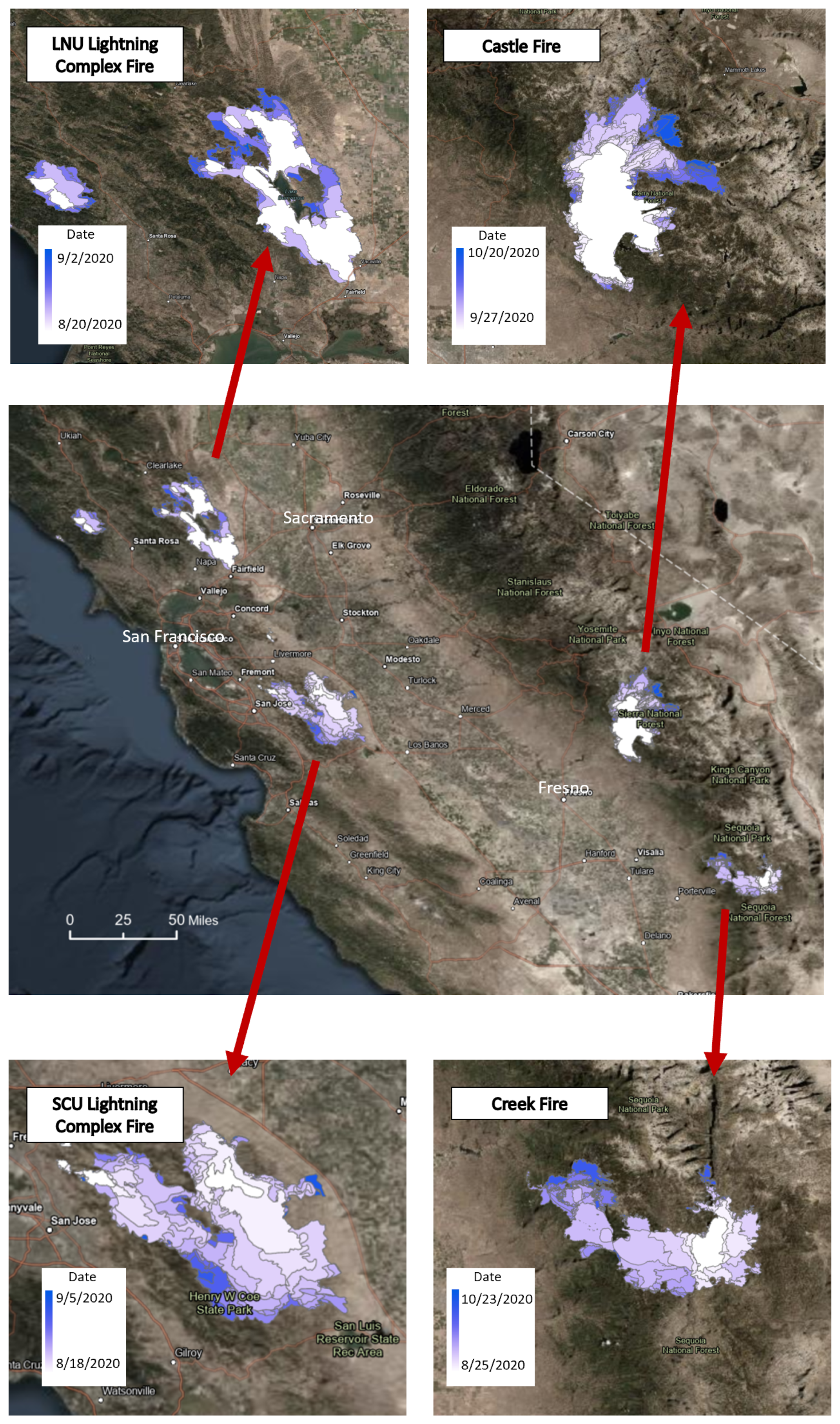
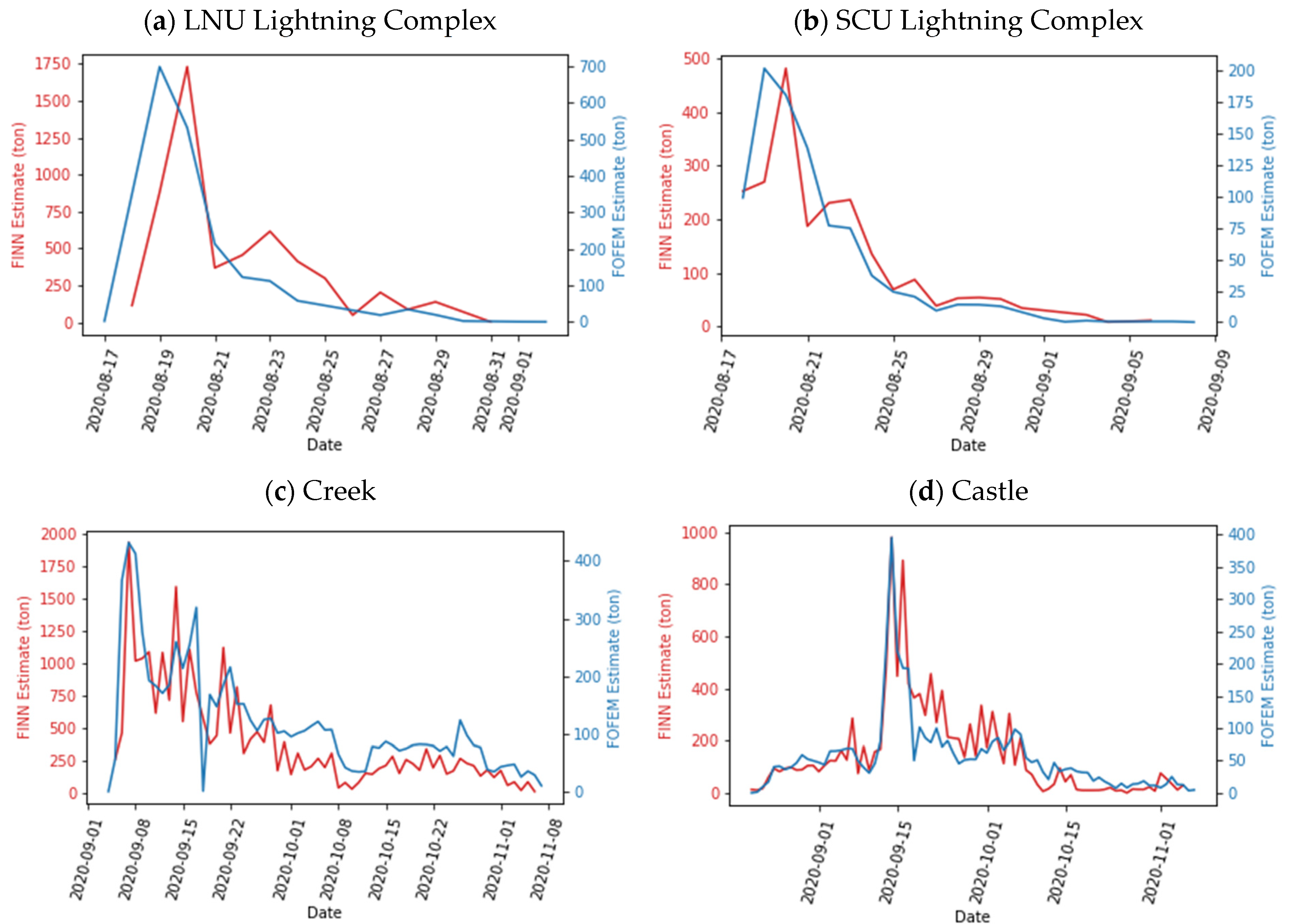
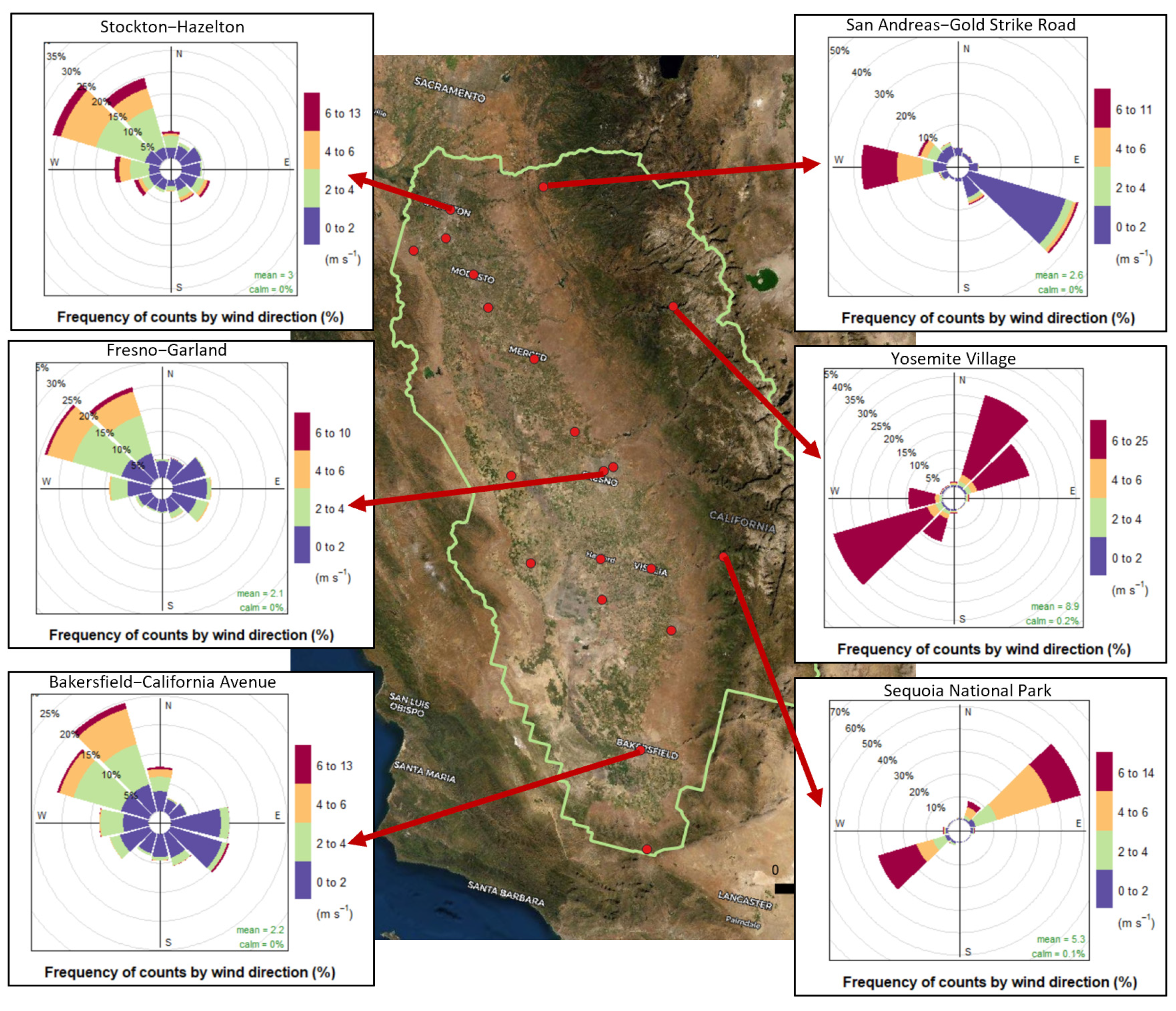
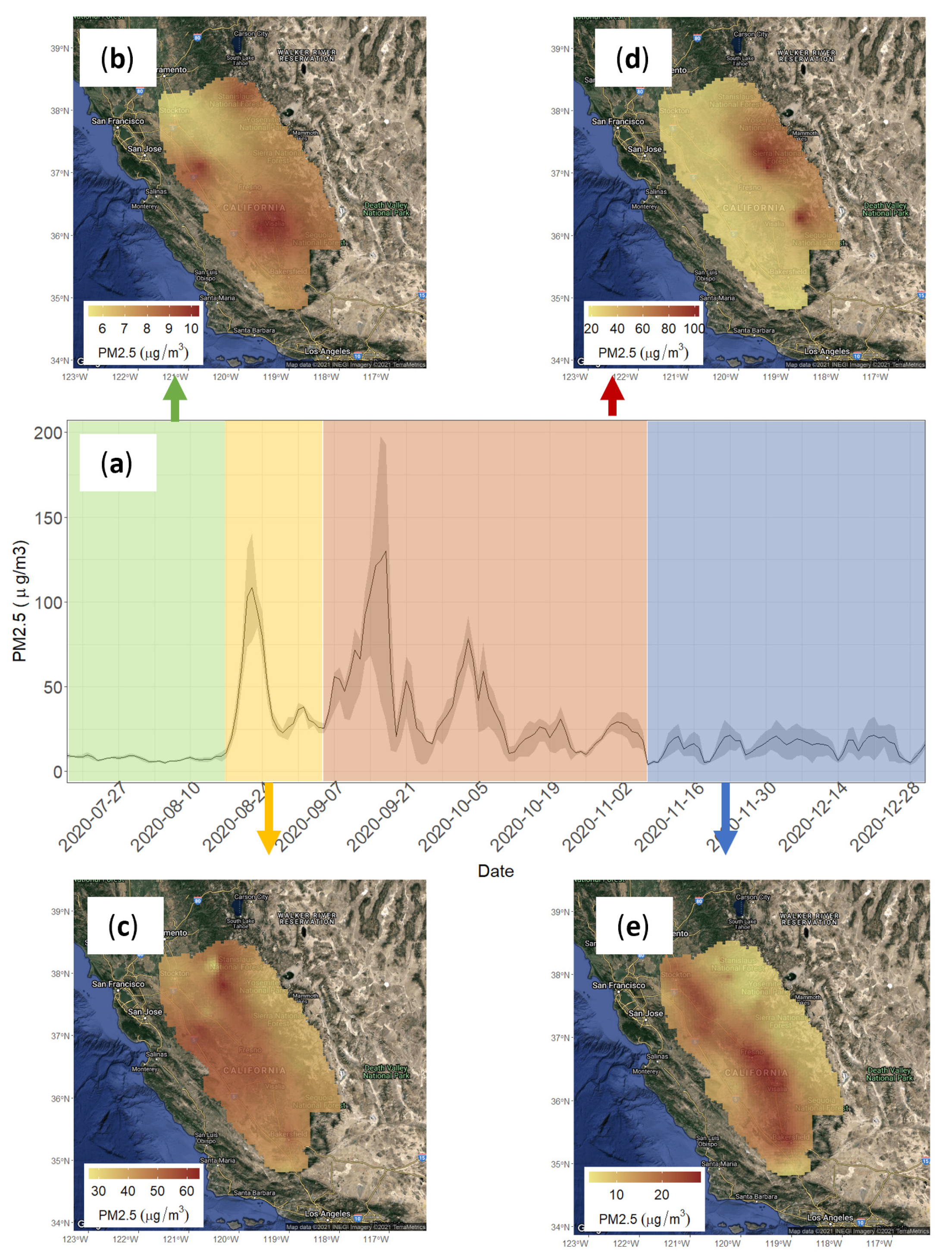
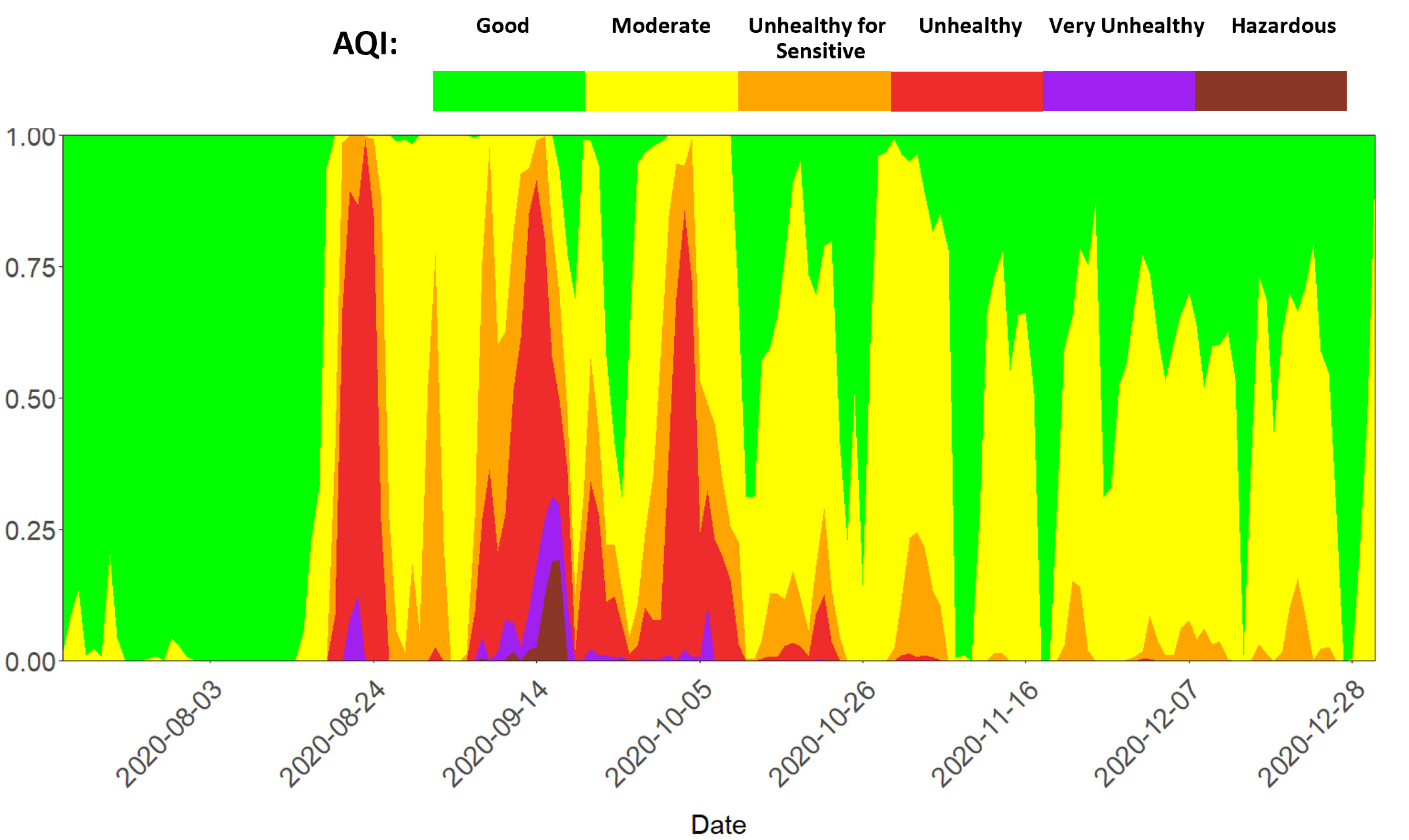
| Fire | Origin Date | Containment Date | Coordinates | Maximum Size (Acres) |
|---|---|---|---|---|
| Creek | 4 September 2020 | 31 December 2020 | 37.201 latitude −117.272 longitude | 379,895 |
| SQF/Castle | 19 August 2020 | Unknown | 36.255 latitude −118.479 longitude | 174,178 |
| LNU Lightning Complex | 17 August 2020 | 2 October 2020 | 38.48193 latitude −122.14864 longitude | 363,220 |
| SCU Lightning Complex | 18 August 2020 | 1 October 2020 | 37.439437 latitude −121.30435 longitude | 396,624 |
Publisher’s Note: MDPI stays neutral with regard to jurisdictional claims in published maps and institutional affiliations. |
© 2022 by the authors. Licensee MDPI, Basel, Switzerland. This article is an open access article distributed under the terms and conditions of the Creative Commons Attribution (CC BY) license (https://creativecommons.org/licenses/by/4.0/).
Share and Cite
Enayati Ahangar, F.; Cobian-Iñiguez, J.; Cisneros, R. Combining Regulatory Instruments and Low-Cost Sensors to Quantify the Effects of 2020 California Wildfires on PM2.5 in San Joaquin Valley. Fire 2022, 5, 64. https://doi.org/10.3390/fire5030064
Enayati Ahangar F, Cobian-Iñiguez J, Cisneros R. Combining Regulatory Instruments and Low-Cost Sensors to Quantify the Effects of 2020 California Wildfires on PM2.5 in San Joaquin Valley. Fire. 2022; 5(3):64. https://doi.org/10.3390/fire5030064
Chicago/Turabian StyleEnayati Ahangar, Faraz, Jeanette Cobian-Iñiguez, and Ricardo Cisneros. 2022. "Combining Regulatory Instruments and Low-Cost Sensors to Quantify the Effects of 2020 California Wildfires on PM2.5 in San Joaquin Valley" Fire 5, no. 3: 64. https://doi.org/10.3390/fire5030064
APA StyleEnayati Ahangar, F., Cobian-Iñiguez, J., & Cisneros, R. (2022). Combining Regulatory Instruments and Low-Cost Sensors to Quantify the Effects of 2020 California Wildfires on PM2.5 in San Joaquin Valley. Fire, 5(3), 64. https://doi.org/10.3390/fire5030064






